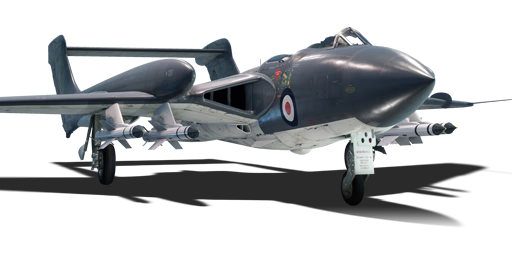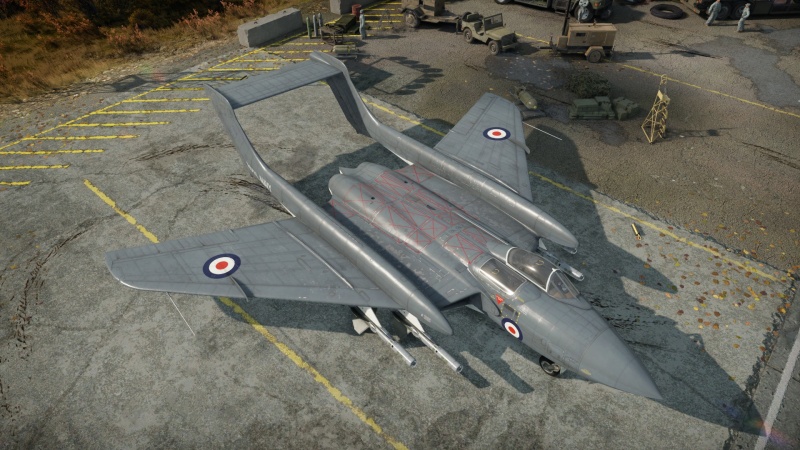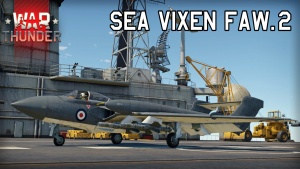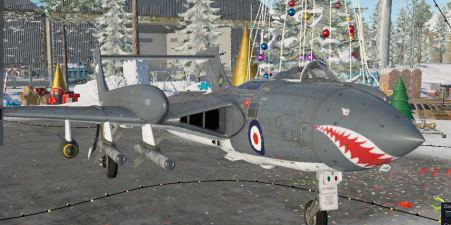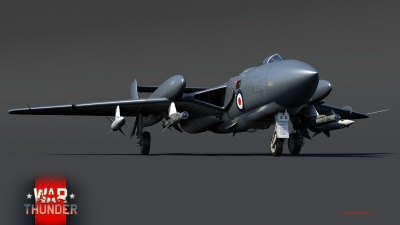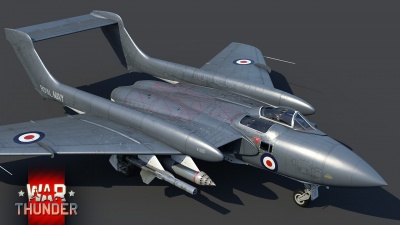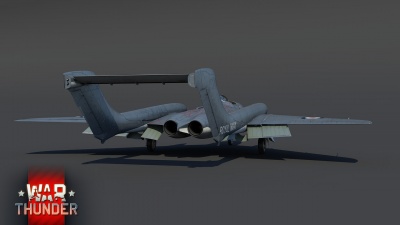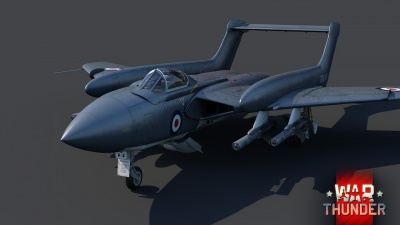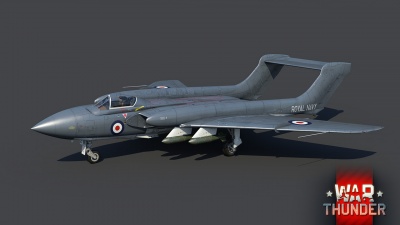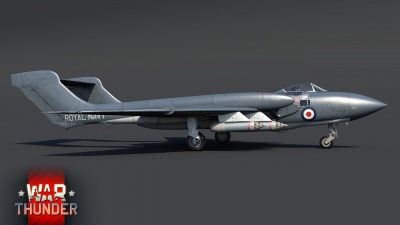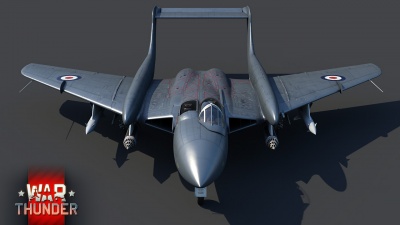Difference between revisions of "Sea Vixen F.A.W. Mk.2"
m (Minor update so that the air RB section is still relevant to the current day) |
m (→Usage in battles) |
||
| (5 intermediate revisions by 5 users not shown) | |||
| Line 6: | Line 6: | ||
== Description == | == Description == | ||
<!-- ''In the description, the first part should be about the history of and the creation and combat usage of the aircraft, as well as its key features. In the second part, tell the reader about the aircraft in the game. Insert a screenshot of the vehicle, so that if the novice player does not remember the vehicle by name, he will immediately understand what kind of vehicle the article is talking about.'' --> | <!-- ''In the description, the first part should be about the history of and the creation and combat usage of the aircraft, as well as its key features. In the second part, tell the reader about the aircraft in the game. Insert a screenshot of the vehicle, so that if the novice player does not remember the vehicle by name, he will immediately understand what kind of vehicle the article is talking about.'' --> | ||
| − | During the late 1940s, de Havilland Aircraft Company set out to create the ultimate naval aircraft for the Royal Navy. The requirements set forth by the Royal Navy's Fleet Air Arm dictated a reliable, high-speed, all-weather fleet defence strike fighter, armed with not only the latest developments in British air-to-air missile technology and a powerful radar, but also a respectable quantity of ground ordnance, including guided ordnance. De Havilland would set out to build the DH.110 prototype, which not only surpassed all expectations by being faster and more heavily armed than requested, but was also good enough to be submitted to the Royal Air Force for consideration in their upcoming interceptor selection. While initially the DH.110 fared very poorly, having the initial prototype disintegrate in the middle of an airshow and killing 31 people, almost directly causing it to lose out in both selections to the [[Sea Venom FAW 20|Sea Venom]] which was cheaper and more readily available for the Royal Navy, and the [[Javelin F.(A.W.) Mk.9|Javelin]] interceptor which was favoured more by the RAF. This did not stop de Havilland, who saw the potential in their fighter, from developing the DH.110 further under their own funds, and shortly after, returned to the | + | During the late 1940s, de Havilland Aircraft Company set out to create the ultimate naval aircraft for the Royal Navy. The requirements set forth by the Royal Navy's Fleet Air Arm dictated a reliable, high-speed, all-weather fleet defence strike fighter, armed with not only the latest developments in British air-to-air missile technology and a powerful radar, but also a respectable quantity of ground ordnance, including guided ordnance. De Havilland would set out to build the DH.110 prototype, which not only surpassed all expectations by being faster and more heavily armed than requested, but was also good enough to be submitted to the Royal Air Force for consideration in their upcoming interceptor selection. While initially the DH.110 fared very poorly, having the initial prototype disintegrate in the middle of an airshow and killing 31 people, almost directly causing it to lose out in both selections to the [[Sea Venom FAW 20|Sea Venom]] which was cheaper and more readily available for the Royal Navy, and the [[Javelin F.(A.W.) Mk.9|Javelin]] interceptor which was favoured more by the RAF. This did not stop de Havilland, who saw the potential in their fighter, from developing the DH.110 further under their own funds, and shortly after, returned to the Royal Navy with a proposal for an updated version, which could accommodate the latest British missiles such as the Firestreak, and had its safety issues ironed out. The Royal Navy would order 148 of the type, now called the "Sea Vixen", and they would enter service very shortly after in 1959. Despite the attempts at fixing the safety issues, the Sea Vixen remained one of the most dangerous aircraft to enter service with the Royal Navy, with over a third of the Sea Vixens in service being lost in accidents. 30 of these (54% of the accidents) were fatal, and eventually, the Sea Vixen was relegated to peacekeeping and target tug roles, almost never seeing actual combat (with the exception of air-cover missions for Royal Navy helicopters/ships in Tanganyika and the Persian Gulf). |
The '''{{Specs|name}}''' was introduced in [[Update "Red Skies"]]. While on the more expensive side of rank V premiums, the cost is justified as this aircraft is very good in most aspects against almost all aircraft it can face against. Most aircraft you face cannot keep up with you in a turn, and those that can, will be unable to catch you in a straight line. The main highlight of this aircraft is its versatility in both air and ground battles. In air battles, while limited by its weak roll rate and lack of ballistic ordnance such as cannons or guns, the Sea Vixen gets access to the [[Red Top]] air-to-air missile, which at its battle rating is strong against most targets it faces, with the exception of the A-4Es with flares. This aircraft also shines in mixed battles, with the ability to bring a decent selection of bombs, rockets, and the [[AGM-12B Bullpup|AGM-12B]] Bullpup guided missiles. All in all, the Sea Vixen proves not only a very versatile aircraft, but a good premium for grinding the respective ranks of the British aircraft tree. | The '''{{Specs|name}}''' was introduced in [[Update "Red Skies"]]. While on the more expensive side of rank V premiums, the cost is justified as this aircraft is very good in most aspects against almost all aircraft it can face against. Most aircraft you face cannot keep up with you in a turn, and those that can, will be unable to catch you in a straight line. The main highlight of this aircraft is its versatility in both air and ground battles. In air battles, while limited by its weak roll rate and lack of ballistic ordnance such as cannons or guns, the Sea Vixen gets access to the [[Red Top]] air-to-air missile, which at its battle rating is strong against most targets it faces, with the exception of the A-4Es with flares. This aircraft also shines in mixed battles, with the ability to bring a decent selection of bombs, rockets, and the [[AGM-12B Bullpup|AGM-12B]] Bullpup guided missiles. All in all, the Sea Vixen proves not only a very versatile aircraft, but a good premium for grinding the respective ranks of the British aircraft tree. | ||
| Line 118: | Line 118: | ||
== Armaments == | == Armaments == | ||
{{Specs-Avia-Armaments}} | {{Specs-Avia-Armaments}} | ||
| − | |||
=== Suspended armament === | === Suspended armament === | ||
{{Specs-Avia-Suspended}} | {{Specs-Avia-Suspended}} | ||
<!-- ''Describe the aircraft's suspended armament: additional cannons under the wings, bombs, rockets and torpedoes. This section is especially important for bombers and attackers. If there is no suspended weaponry remove this subsection.'' --> | <!-- ''Describe the aircraft's suspended armament: additional cannons under the wings, bombs, rockets and torpedoes. This section is especially important for bombers and attackers. If there is no suspended weaponry remove this subsection.'' --> | ||
| − | |||
| − | |||
| − | |||
| − | The '''''{{PAGENAME}}''''' can be outfitted with the following ordnance | + | The '''''{{PAGENAME}}''''' can be outfitted with the following ordnance: |
| − | |||
| − | |||
| − | |||
| − | |||
| − | |||
| − | |||
| − | |||
| − | |||
| − | |||
| − | |||
| − | |||
| − | |||
| − | |||
| − | |||
| − | |||
| − | |||
{| class="wikitable" style="text-align:center" width="100%" | {| class="wikitable" style="text-align:center" width="100%" | ||
|- | |- | ||
| Line 150: | Line 130: | ||
| rowspan="11" width="30%" | <div class="ttx-image">[[File:Hardpoints_{{PAGENAME}}.png]]</div> | | rowspan="11" width="30%" | <div class="ttx-image">[[File:Hardpoints_{{PAGENAME}}.png]]</div> | ||
|- | |- | ||
| − | ! 500 lb H.E. M.C. Mk.II bombs | + | ! [[H.E. M.C. Mk.II (500 lb)|500 lb H.E. M.C. Mk.II]] bombs |
| || 1 || 1 || 1 || 1 || | | || 1 || 1 || 1 || 1 || | ||
|- | |- | ||
| − | ! 540 lb Mk.M2 bombs | + | ! [[Mk.M2 (540 lb)|540 lb Mk.M2]] bombs |
| || 1 || 1 || 1 || 1 || | | || 1 || 1 || 1 || 1 || | ||
|- | |- | ||
| − | ! 1,000 lb H.E. M.C. Mk.13 bombs | + | ! [[H.E. M.C. Mk.13 (1,000 lb)|1,000 lb H.E. M.C. Mk.13]] bombs |
| 1 || || || || || 1 | | 1 || || || || || 1 | ||
|- | |- | ||
| − | ! AP Mk II rockets | + | ! [[AP Mk II]] rockets |
| || 6 || 6 || 6 || 6 || | | || 6 || 6 || 6 || 6 || | ||
|- | |- | ||
| − | ! RP rockets | + | ! [[RP]] rockets |
| || 36 || 36 || 36 || 36 || | | || 36 || 36 || 36 || 36 || | ||
|- | |- | ||
| − | ! RP-3 rockets | + | ! [[RP-3]] rockets |
| || 4 || 4 || 4 || 4 || | | || 4 || 4 || 4 || 4 || | ||
|- | |- | ||
| − | ! AGM-12B Bullpup missiles | + | ! [[AGM-12B Bullpup]] missiles |
| 1 || || || || || 1 | | 1 || || || || || 1 | ||
|- | |- | ||
| − | ! Firestreak missiles | + | ! [[Firestreak]] missiles |
| || 1* || 1* || 1* || 1* || | | || 1* || 1* || 1* || 1* || | ||
|- | |- | ||
| − | ! Red Top missiles | + | ! [[Red Top]] missiles |
| || 1* || 1* || 1* || 1* || | | || 1* || 1* || 1* || 1* || | ||
|- | |- | ||
| Line 181: | Line 161: | ||
| colspan="8" | * Firestreak and Red Top air-to-air missiles cannot be mixed, only one type may be carried across hardpoints | | colspan="8" | * Firestreak and Red Top air-to-air missiles cannot be mixed, only one type may be carried across hardpoints | ||
|} | |} | ||
| + | |||
| + | {{Navigation-Start|Default weapon presets}} | ||
| + | {{Navigation-First-Simple-Line}} | ||
| + | |||
| + | * 4 x Firestreak missiles | ||
| + | * 4 x Red Top missiles | ||
| + | * 4 x 500 lb H.E. M.C. Mk.II bombs (2,000 lb total) | ||
| + | * 4 x 540 lb Mk.M2 bombs (2,160 lb total) | ||
| + | * 2 x 1,000 lb H.E. M.C. Mk.13 bombs (2,000 lb total) | ||
| + | * 16 x RP-3 rockets | ||
| + | * 24 x AP Mk II rockets | ||
| + | * 144 x RP rockets | ||
| + | * 2 x AGM-12B Bullpup missiles | ||
| + | * 2 x 1,000 lb H.E. M.C. Mk.13 bombs + 4 x 540 lb Mk.M2 bombs (4,160 lb total) | ||
| + | * 2 x AGM-12B Bullpup missiles + 4 x Firestreak missiles | ||
| + | * 2 x AGM-12B Bullpup missiles + 144 x RP rockets | ||
| + | * 2 x Red Top missiles + 72 x RP rockets | ||
| + | * 2 x Red Top missiles + 2 x 500 lb H.E. M.C. Mk.II bombs + 2 x AGM-12B Bullpup missiles (1,000 lb total) | ||
| + | {{Navigation-End}} | ||
== Usage in battles == | == Usage in battles == | ||
<!-- ''Describe the tactics of playing in the aircraft, the features of using aircraft in a team and advice on tactics. Refrain from creating a "guide" - do not impose a single point of view, but instead, give the reader food for thought. Examine the most dangerous enemies and give recommendations on fighting them. If necessary, note the specifics of the game in different modes (AB, RB, SB).'' --> | <!-- ''Describe the tactics of playing in the aircraft, the features of using aircraft in a team and advice on tactics. Refrain from creating a "guide" - do not impose a single point of view, but instead, give the reader food for thought. Examine the most dangerous enemies and give recommendations on fighting them. If necessary, note the specifics of the game in different modes (AB, RB, SB).'' --> | ||
| + | [[File:Sea Vixen Wiki Image 3.jpg|thumb|Sea Vixen launching a [[Firestreak]] AAM.]] | ||
;Air Realistic battles | ;Air Realistic battles | ||
| − | The '''Red Tops''' are generally much better missiles to equip, compared to the '''Firestreaks''', as they have the largest warhead of any air-to-air missile in the game and have a slightly better top speed (Mach 2.5). Because of this, the | + | The '''Red Tops''' are generally much better missiles to equip, compared to the '''Firestreaks''', as they have the largest warhead of any air-to-air missile in the game and have a slightly better top speed (Mach 2.5). Because of this, the Sea Vixen's best tactic is to climb to one side at the start of the battle and attack enemy bombers. The Red Tops are very good for attacking from the side and this tactic is a good idea to avoid enemy tail gunners and will make the missile more likely to hit because of the Red Tops' poor range from the rear. |
| + | |||
| + | Alternatively, you can use the Red Tops in Boom-n-Zoom attacks on enemy fighters, who are not watching out for missiles or fighters, which have lost speed. The Red Tops are most useful when fired from the side between 1 to 2.5 km range. The Sea Vixen's manoeuvrability may tempt you to engage in dogfights, however, you should generally stick to boom-and-zoom tactics at least until there are only a few hostile aircraft left; The Sea Vixen's primary way of avoiding damage is its superior speed and engaging in dogfights gives a chance to hostiles to get a hit on you. | ||
| + | |||
| + | Remember to actively use your radar lock, the Sea Vixen's radar lock is superior to even some top-tier aircraft and allows you to get a missile lock without needing to have your aircraft's nose pointed at the target. It can also help you acquire a lock more easily on turning aircraft and it is generally good practice to radar lock any target you are going after. | ||
| + | |||
| + | ;Enemies worth noting: | ||
| + | |||
| + | MiG-19s and F-104s in particular need to be looked out for as they are common and among the very few aircraft able to catch up to the Sea Vixen. In a downtier, A-4Es are the primary target that should be avoided, as they possess flares. | ||
| − | + | While the [[Tu-4]] and [[Tu-4 (China)|its Chinese counterpart]] may seems like an easy target at the first glance, they can render your missile useless by turning off all of their engines and preventing you from acquiring a lock until at a point blank range. As such, avoid engaging them if you are aware that they have turned off the engines and you have failed to lock on them. | |
| − | + | ;Strategies for specific aircraft: | |
| − | + | * [[F-104 (Family)|F-104 ''Starfighter'']]: In uptiers, the most common aircraft you will face is the F-104s. Unfortunately, you will see very few bombers in these cases, so you will most likely have to deal with them one way or another. | |
| + | ** Your ideal engagement is intercepting an F-104 that is diving on another target (or just cruising) from the sides, the Sea Vixen has great manoeuvrability and can easily get on an aircraft's tail. When you are on the tail of a F-104, quickly judge its speed, if it is going near your top speed, your desired missile launch range is within 1.5km; Red Tops have subpar burn time and cannot catch up if launched from any further. | ||
| + | ** If the target F-104 tries to dogfight you, quickly check your surroundings, if there are no other hostile aircraft in sight, feel free to respond in kind. The Sea Vixen is far more manoeuvrable than the F-104, you have the upper hand. | ||
| − | + | * [[A-4 (Family)|A-4 ''Skyhawk'']]: The strategy against A-4s is generally just brute force. You can get on their tail and pressure them, you are both faster and more manoeuvrable so you can afford a protracted fight (given there are no other hostiles in the vicinity). | |
| − | * | + | ** The ideal situation is when the target A-4 is confident in its flares and is flying straight. In that case, you may get between 0.5 to 0.7 km of them, the close distance gives them very little time to react, and even if they do drop flares in time, good chances are that the flares won't have time to travel far enough from the A-4 and as such the missile will still damage them simply by exploding close to them. |
| − | + | ** If the A-4 turns, use your radar lock to get a missile lock and launch the missile ahead of its turn. The missile will then be less likely to be fooled by flares as the flares will be too far back comparatively. | |
| − | |||
| − | |||
| − | |||
| − | |||
[[File:Sea Vixen Wiki Image 4.jpg|thumb|Sea Vixen after destroying a target with its [[AGM-12B Bullpup|AGM-12B]] Bullpup.]] | [[File:Sea Vixen Wiki Image 4.jpg|thumb|Sea Vixen after destroying a target with its [[AGM-12B Bullpup|AGM-12B]] Bullpup.]] | ||
| Line 211: | Line 217: | ||
* Very high top speed of over 1,100 km/h at sea level | * Very high top speed of over 1,100 km/h at sea level | ||
| − | * Good acceleration thanks to its two powerful engines | + | * Good acceleration and climb rate thanks to its two powerful engines |
* [[Red Top]] missiles can be very hard to dodge when used correctly | * [[Red Top]] missiles can be very hard to dodge when used correctly | ||
| − | * | + | * Surprisingly manoeuvrable, despite the size |
| − | + | * Decent ground attack ordnance loadouts, including [[AGM-12B Bullpup]] air-to-ground missiles | |
| − | * | ||
| − | |||
| − | |||
* Can take-off and land from aircraft carriers | * Can take-off and land from aircraft carriers | ||
| − | * The AI Mk.18 radar is better than that found on most aircraft you face | + | * The AI Mk.18 radar is better than that found on most aircraft you face |
'''Cons:''' | '''Cons:''' | ||
* The Sea Vixen has no guns or cannons, relying entirely on missiles for air-to-air combat | * The Sea Vixen has no guns or cannons, relying entirely on missiles for air-to-air combat | ||
| + | ** Only having four air-to-air missiles with no other air-to-air armament limits how many kills you can get without re-arming. Targets with flares can be very hard to kill as a result | ||
| + | ** Having only missiles enforces a fairly high minimum engagement range on you (missiles require time to start tracking after launch, and arm their proximity fuse). | ||
* Missiles are rear-aspect only so you cannot engage targets you are approaching head-on (or from the front aspect in general) | * Missiles are rear-aspect only so you cannot engage targets you are approaching head-on (or from the front aspect in general) | ||
| − | * Both [[Red Top]] and [[Firestreak]] missiles do not have great range when fired from directly behind a target | + | * Both [[Red Top]] and [[Firestreak]] missiles do not have great range when fired from directly behind a target |
| − | * | + | * Very large in size, can be easily hit by most enemies |
| − | |||
| − | |||
| − | |||
== History == | == History == | ||
Latest revision as of 01:57, 20 November 2024
Contents
Description
During the late 1940s, de Havilland Aircraft Company set out to create the ultimate naval aircraft for the Royal Navy. The requirements set forth by the Royal Navy's Fleet Air Arm dictated a reliable, high-speed, all-weather fleet defence strike fighter, armed with not only the latest developments in British air-to-air missile technology and a powerful radar, but also a respectable quantity of ground ordnance, including guided ordnance. De Havilland would set out to build the DH.110 prototype, which not only surpassed all expectations by being faster and more heavily armed than requested, but was also good enough to be submitted to the Royal Air Force for consideration in their upcoming interceptor selection. While initially the DH.110 fared very poorly, having the initial prototype disintegrate in the middle of an airshow and killing 31 people, almost directly causing it to lose out in both selections to the Sea Venom which was cheaper and more readily available for the Royal Navy, and the Javelin interceptor which was favoured more by the RAF. This did not stop de Havilland, who saw the potential in their fighter, from developing the DH.110 further under their own funds, and shortly after, returned to the Royal Navy with a proposal for an updated version, which could accommodate the latest British missiles such as the Firestreak, and had its safety issues ironed out. The Royal Navy would order 148 of the type, now called the "Sea Vixen", and they would enter service very shortly after in 1959. Despite the attempts at fixing the safety issues, the Sea Vixen remained one of the most dangerous aircraft to enter service with the Royal Navy, with over a third of the Sea Vixens in service being lost in accidents. 30 of these (54% of the accidents) were fatal, and eventually, the Sea Vixen was relegated to peacekeeping and target tug roles, almost never seeing actual combat (with the exception of air-cover missions for Royal Navy helicopters/ships in Tanganyika and the Persian Gulf).
The DH.110 Sea Vixen F.A.W. Mk.2 was introduced in Update "Red Skies". While on the more expensive side of rank V premiums, the cost is justified as this aircraft is very good in most aspects against almost all aircraft it can face against. Most aircraft you face cannot keep up with you in a turn, and those that can, will be unable to catch you in a straight line. The main highlight of this aircraft is its versatility in both air and ground battles. In air battles, while limited by its weak roll rate and lack of ballistic ordnance such as cannons or guns, the Sea Vixen gets access to the Red Top air-to-air missile, which at its battle rating is strong against most targets it faces, with the exception of the A-4Es with flares. This aircraft also shines in mixed battles, with the ability to bring a decent selection of bombs, rockets, and the AGM-12B Bullpup guided missiles. All in all, the Sea Vixen proves not only a very versatile aircraft, but a good premium for grinding the respective ranks of the British aircraft tree.
General info
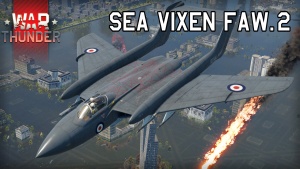
Flight performance
| Characteristics | Max Speed (km/h at 100 m) |
Max altitude (metres) |
Turn time (seconds) |
Rate of climb (metres/second) |
Take-off run (metres) | |||
|---|---|---|---|---|---|---|---|---|
| AB | RB | AB | RB | AB | RB | |||
| Stock | 1,109 | 1,093 | 13000 | 24.5 | 25.5 | 42.7 | 39.4 | 325 |
| Upgraded | 1,117 | 1,109 | 23.6 | 24.0 | 68.8 | 55.0 | ||
Details
| Features | |||||
|---|---|---|---|---|---|
| Combat flaps | Take-off flaps | Landing flaps | Air brakes | Arrestor gear | Drogue chute |
| X | ✓ | ✓ | ✓ | ✓ | X |
| Limits | ||||||
|---|---|---|---|---|---|---|
| Wings (km/h) | Gear (km/h) | Flaps (km/h) | Max Static G | |||
| Combat | Take-off | Landing | + | - | ||
| 1,195 | 407 | N/A | 407 | 324 | ~9 | ~5 |
| Optimal velocities (km/h) | |||
|---|---|---|---|
| Ailerons | Rudder | Elevators | Radiator |
| < 685 | < 750 | < 440 | N/A |
Engine performance
| Engine | Aircraft mass | |||||
|---|---|---|---|---|---|---|
| Engine name | Number | Basic mass | Wing loading (full fuel) | |||
| Rolls-Royce Avon Mk.208 | 2 | 12,872 kg | 291 kg/m2 | |||
| Engine characteristics | Mass with fuel (no weapons load) | Max Takeoff Weight | ||||
| Weight (each) | Type | 8m fuel | 20m fuel | 26m fuel | ||
| 2,361 kg | Axial-flow turbojet | 14,274 kg | 16,359 kg | 17,545 kg | 21,205 kg | |
| Maximum engine thrust @ 0 m (RB/SB) | Thrust to weight ratio @ 0 m (100%) | |||||
| Condition | 100% | WEP | 8m fuel | 20m fuel | 26m fuel | MTOW |
| Stationary | 5,029 kgf | N/A | 0.70 | 0.61 | 0.57 | 0.47 |
| Optimal | 5,029 kgf (0 km/h) |
N/A | 0.70 | 0.61 | 0.57 | 0.47 |
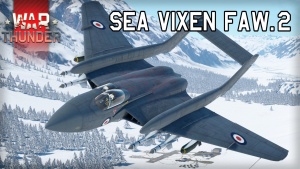
Survivability and armour
The Sea Vixen FAW.2 has no armour plates but has bulletproof glass for the pilot. The engines are both mounted in the centre of the airframe, with fuel tanks mainly in the wings. The tail overall is fairly weak and can be blown off easily by large calibre cannons, however the flap on the rear of the elevator can sometimes absorb shots, protecting the main elevator from damage. Unfortunately the Sea Vixen generally handles poorly when damaged, performance is reduced fairly significantly by damage to the wings and asymmetric damage can make control very difficult.
Modifications and economy
Armaments
Suspended armament
The Sea Vixen F.A.W. Mk.2 can be outfitted with the following ordnance:
| 1 | 2 | 3 | 4 | 5 | 6 | ||
|---|---|---|---|---|---|---|---|
| 500 lb H.E. M.C. Mk.II bombs | 1 | 1 | 1 | 1 | |||
| 540 lb Mk.M2 bombs | 1 | 1 | 1 | 1 | |||
| 1,000 lb H.E. M.C. Mk.13 bombs | 1 | 1 | |||||
| AP Mk II rockets | 6 | 6 | 6 | 6 | |||
| RP rockets | 36 | 36 | 36 | 36 | |||
| RP-3 rockets | 4 | 4 | 4 | 4 | |||
| AGM-12B Bullpup missiles | 1 | 1 | |||||
| Firestreak missiles | 1* | 1* | 1* | 1* | |||
| Red Top missiles | 1* | 1* | 1* | 1* | |||
| Maximum permissible weight imbalance: 700 kg | |||||||
| * Firestreak and Red Top air-to-air missiles cannot be mixed, only one type may be carried across hardpoints | |||||||
| Default weapon presets | |
|---|---|
| |
Usage in battles
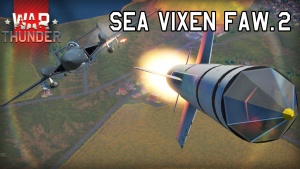
- Air Realistic battles
The Red Tops are generally much better missiles to equip, compared to the Firestreaks, as they have the largest warhead of any air-to-air missile in the game and have a slightly better top speed (Mach 2.5). Because of this, the Sea Vixen's best tactic is to climb to one side at the start of the battle and attack enemy bombers. The Red Tops are very good for attacking from the side and this tactic is a good idea to avoid enemy tail gunners and will make the missile more likely to hit because of the Red Tops' poor range from the rear.
Alternatively, you can use the Red Tops in Boom-n-Zoom attacks on enemy fighters, who are not watching out for missiles or fighters, which have lost speed. The Red Tops are most useful when fired from the side between 1 to 2.5 km range. The Sea Vixen's manoeuvrability may tempt you to engage in dogfights, however, you should generally stick to boom-and-zoom tactics at least until there are only a few hostile aircraft left; The Sea Vixen's primary way of avoiding damage is its superior speed and engaging in dogfights gives a chance to hostiles to get a hit on you.
Remember to actively use your radar lock, the Sea Vixen's radar lock is superior to even some top-tier aircraft and allows you to get a missile lock without needing to have your aircraft's nose pointed at the target. It can also help you acquire a lock more easily on turning aircraft and it is generally good practice to radar lock any target you are going after.
- Enemies worth noting
MiG-19s and F-104s in particular need to be looked out for as they are common and among the very few aircraft able to catch up to the Sea Vixen. In a downtier, A-4Es are the primary target that should be avoided, as they possess flares.
While the Tu-4 and its Chinese counterpart may seems like an easy target at the first glance, they can render your missile useless by turning off all of their engines and preventing you from acquiring a lock until at a point blank range. As such, avoid engaging them if you are aware that they have turned off the engines and you have failed to lock on them.
- Strategies for specific aircraft
- F-104 Starfighter: In uptiers, the most common aircraft you will face is the F-104s. Unfortunately, you will see very few bombers in these cases, so you will most likely have to deal with them one way or another.
- Your ideal engagement is intercepting an F-104 that is diving on another target (or just cruising) from the sides, the Sea Vixen has great manoeuvrability and can easily get on an aircraft's tail. When you are on the tail of a F-104, quickly judge its speed, if it is going near your top speed, your desired missile launch range is within 1.5km; Red Tops have subpar burn time and cannot catch up if launched from any further.
- If the target F-104 tries to dogfight you, quickly check your surroundings, if there are no other hostile aircraft in sight, feel free to respond in kind. The Sea Vixen is far more manoeuvrable than the F-104, you have the upper hand.
- A-4 Skyhawk: The strategy against A-4s is generally just brute force. You can get on their tail and pressure them, you are both faster and more manoeuvrable so you can afford a protracted fight (given there are no other hostiles in the vicinity).
- The ideal situation is when the target A-4 is confident in its flares and is flying straight. In that case, you may get between 0.5 to 0.7 km of them, the close distance gives them very little time to react, and even if they do drop flares in time, good chances are that the flares won't have time to travel far enough from the A-4 and as such the missile will still damage them simply by exploding close to them.
- If the A-4 turns, use your radar lock to get a missile lock and launch the missile ahead of its turn. The missile will then be less likely to be fooled by flares as the flares will be too far back comparatively.
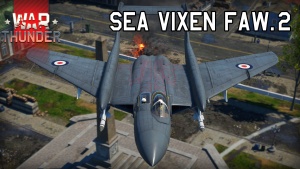
Pros and cons
Pros:
- Very high top speed of over 1,100 km/h at sea level
- Good acceleration and climb rate thanks to its two powerful engines
- Red Top missiles can be very hard to dodge when used correctly
- Surprisingly manoeuvrable, despite the size
- Decent ground attack ordnance loadouts, including AGM-12B Bullpup air-to-ground missiles
- Can take-off and land from aircraft carriers
- The AI Mk.18 radar is better than that found on most aircraft you face
Cons:
- The Sea Vixen has no guns or cannons, relying entirely on missiles for air-to-air combat
- Only having four air-to-air missiles with no other air-to-air armament limits how many kills you can get without re-arming. Targets with flares can be very hard to kill as a result
- Having only missiles enforces a fairly high minimum engagement range on you (missiles require time to start tracking after launch, and arm their proximity fuse).
- Missiles are rear-aspect only so you cannot engage targets you are approaching head-on (or from the front aspect in general)
- Both Red Top and Firestreak missiles do not have great range when fired from directly behind a target
- Very large in size, can be easily hit by most enemies
History
The de Havilland Sea Vixen is a British twin-boom, twin-engine carrier air-defence aircraft employed by the Royal Navy's Fleet Air Arm from the 1950s to 1970s.
The Royal Navy had interest in a carrier defence fighter after the Second World War, and issued a requirement for such an aircraft in 1946. De Havilland began producing an aircraft, the DH 110, to fulfill this requirement. However, the Fleet Air Arm decided to proceed with the Sea Venom instead as it was cheaper and available sooner. In spite of this, De Havilland continued work on the DH 110 independently, finishing the first prototype in September of 1951. This prototype exceeded expectations and could regularly attain supersonic speeds during test flights.
Tragedy soon struck when the DH 110 prototype disintegrated in midair during the Farnborough Airshow in 1952, resulting in the deaths of 31 people including the crew of two. As a result, the DH 110 underwent significant design changes to improve its structural stability, resulting in its maximum speed being reduced to Mach 0.91. This aircraft was offered to the Fleet Air Arm and replaced the previous Sea Venoms as the RN's primary air defence fighter. In February of 1955, 110 aircraft were ordered, with the name "Sea Vixen".
The Sea Vixen was built with an unconventional twin-boom design, which de Havilland had perfected through its design of the twin-boomed Vampire and Venom fighters. The Sea Vixen was also the first British combat aircraft with no internal gun armament, relying entirely on its suspended ordnance. The FAW.1 variant was capable of carrying 4 Firestreak AAMs for fleet defence, while the FAW.2 variant could carry the more advanced Red Top missile. The aircraft had two Rolls-Royce Avon engines producing 33 kN of thrust each and a crew of two, with the pilot's canopy offset to the left and the radar operator's seat flush within the fuselage.
The first Sea Vixens entered service with frontline squadrons in 1959. The Sea Vixen failed to see any combat action during its short service, but served with the Fleet Air Arm in deployments off of Iraq, Tanganyika (part of modern-day Tanzania), Indonesia, and more. The aircraft were replaced by the more modern Phantom FG.1, a British variant of the American F-4 Phantom II. The last Sea Vixens were retired from active duty in 1972; a total of 145 were built, though 55 had been lost to accidents.
Devblog
Development of the Sea Vixen began in 1946 when de Havilland entered talks with the Admiralty on designing a future radar-equipped naval jet fighter with all-weather capability. Official requirements were drawn up in January 1947, by which time however de Havilland was already working on a design based on the preceding Vampire and Venom fighters designated DH 110.
Despite decreasing interest in the project by the late 1940's, in September 1951, the first prototype conducted its maiden flight. However, only a year later, the same prototype crashed during an air show, thus further impeding the project's progress. While the RAF abandoned the idea of purchasing the DH 110 by the mid 1950's, the FAA gained a renewed interest in the aircraft and placed an order for 110 machines to be built in February 1955. Along with the order, the DH 110 received its official designation 'Sea Vixen'.
As the Sea Vixen entered service with the FAA in 1959, de Havilland took note of the feedback gained from operational use of the aircraft and continued working on the Sea Vixen in an effort to improve its design. As a result, the Sea Vixen FAW.2 made its debut in 1962 which featured a number of improvements, of which one of the more notable ones was the ability to carry the Red Top air-to-air missiles. Over 140 Sea Vixens were built, most of which were converted over to the FAW.2 modification after its commissioning into service.
Although the British Sea Vixens never took part in any wars, they were still involved in a number of different combat operations primarily in Africa and the Middle East where they provided fire support for ground troops and flew patrols.
Media
- Skins
- Camouflages
- Sea Vixen F.A.W. Mk.2 Devblog Images
- Images
- Sea Vixen F.A.W. Mk.2 Devblog Images
- Videos
See also
External links
- [Development] Sea Vixen FAW.2: Breaking Convention
- Official data sheet - more details about the performance
| De Havilland Aircraft Company Limited | |
|---|---|
| Fighters | Hornet Mk.I · Hornet Mk.III · Mosquito FB Mk VI · Mosquito FB Mk XVIII |
| Jet fighters | Vampire F.B.5 · Venom FB.4 · Sea Venom FAW 20 · Sea Vixen F.A.W. Mk.2 |
| Export | ␗Mosquito FB.Mk.26 · ▄Vampire FB 52A(Italy) · ▄Vampire FB 52A(Finland) · A28B |
| Britain jet aircraft | |
|---|---|
| Blackburn | Buccaneer S.1 · Buccaneer S.2 · Buccaneer S.2B |
| British Aerospace | Harrier GR.7 · Sea Harrier FRS.1 (e) · Sea Harrier FRS.1 · Sea Harrier FA 2 |
| British Aircraft Corporation | Strikemaster Mk.88 |
| English Electric | Canberra B Mk 2 · Canberra B (I) Mk 6 · Lightning F.6 · Lightning F.53 |
| Gloster | Meteor F Mk 3 · Sea Meteor F Mk 3 · Meteor F Mk 4 G.41F · Meteor F Mk 4 G.41G · Meteor F Mk 8 G.41K · Meteor F Mk.8 Reaper |
| Javelin F.(A.W.) Mk.9 | |
| de Havilland | Vampire F.B.5 · Venom FB.4 · Sea Venom FAW 20 · Sea Vixen F.A.W. Mk.2 |
| Hawker | Sea Hawk FGA.6 · Hunter F.1 · Hunter F.6 · Hunter FGA.9 · Harrier GR.1 · Harrier GR.3 |
| Panavia | Tornado GR.1 · Tornado GR.4 · Tornado F.3 · Tornado F.3 Late |
| SEPECAT | Jaguar GR.1 · Jaguar GR.1A · Jaguar IS |
| Supermarine | Attacker FB 1 · Attacker FB.2 · Scimitar F Mk.1 · Swift F.1 · Swift F.7 |
| Foreign | Phantom FG.1 (USA) · Phantom FGR.2 (USA) · F-4J(UK) Phantom II (USA) |
| Australia | F-111C |
| India | ▄MiG-21 Bison |
| South Africa | ▄JAS39C |
| Britain premium aircraft | |
|---|---|
| Fighters | Tuck's Gladiator Mk II · ▄Boomerang Mk I · ▄Boomerang Mk II · ▄D.520 |
| ▄Martlet Mk IV · ▄Corsair F Mk II · ▄Hellcat Mk II · ▄Thunderbolt Mk.1 · ▄Mustang Mk IA | |
| Hurricane Mk.I/L FAA M · Spitfire Mk.IIa Venture I · Spitfire F Mk IXc · Plagis' Spitfire LF Mk IXc · Spitfire F Mk XIVc · Prendergast's Spitfire FR Mk XIVe | |
| Typhoon Mk Ib · MB.5 | |
| Twin-engine fighters | Hornet Mk.I · Whirlwind P.9 |
| Jet fighters | Attacker FB.2 · Hunter FGA.9 · Lightning F.53 · Meteor F Mk.8 Reaper · Sea Vixen F.A.W. Mk.2 · F-4J(UK) Phantom II · ▄MiG-21 Bison |
| Strike aircraft | ▄Wirraway · Beaufighter Mk I (40-mm) · Wyvern S4 |
| Harrier GR.1 · Strikemaster Mk.88 | |
| Bombers | ▄Avenger Mk II · ▄Boston Mk I · ▄Catalina Mk IIIa · ▄DB-7 · ▄Havoc Mk I · ▄Hudson Mk V · Swordfish Mk II |


